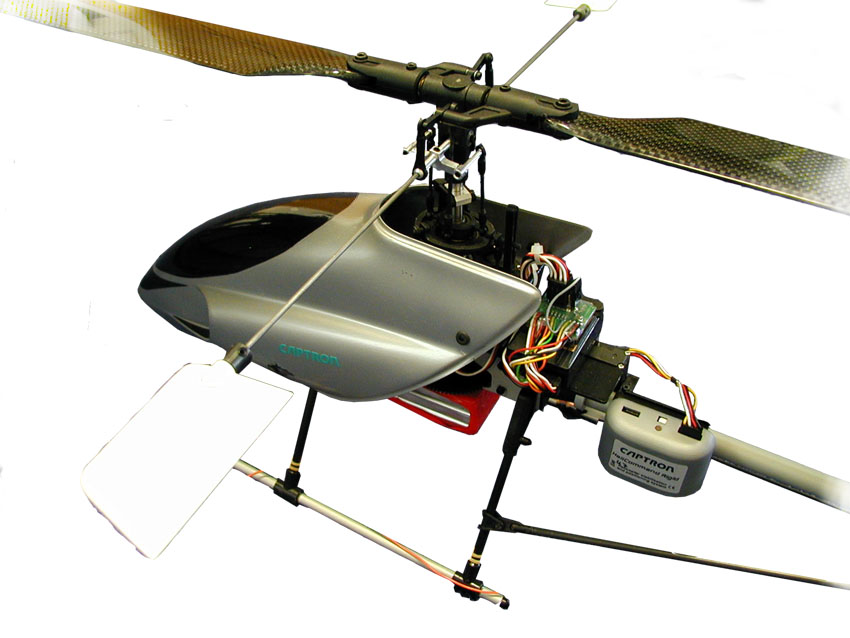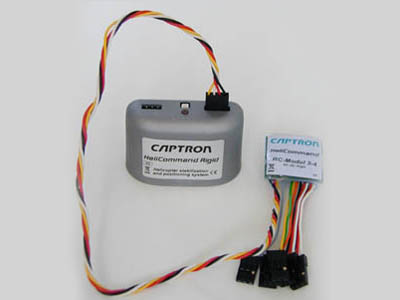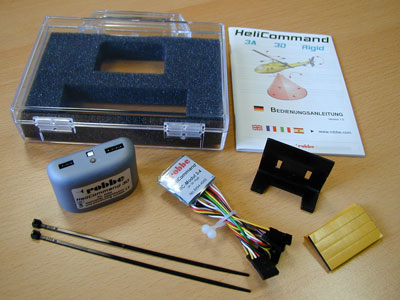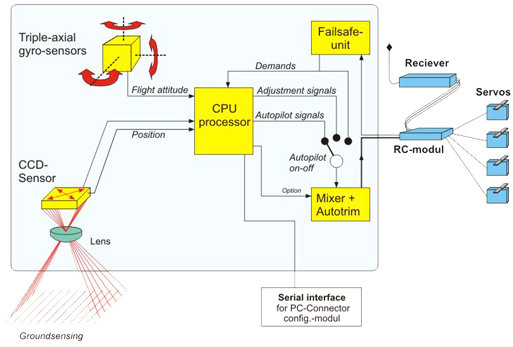
 
The HeliCommand stabilizes the geographical position of the model helicopter it also stabilizes its flight attitude. The HeliCommand incorporates several control and measurement systems (triple axis gyros and an optical CCD sensor) to provide a superb of stability. It is ideal for the beginner. It adds a level of control and confidence that prior to this time has been unavailable to any model helicopter pilot. The HeliCommand provides a level of safety and accident reduction that previously has been unknown in the realm of helicopter modeling. Dual redundancy (in both the hardware and software programming) throughout was designed into the HeliCommand. In addition to all of the above the HeliCommand incorporates a full Failsafe unit incase of radio failure.
Integral functions:
- Tail rotor gyro - The HeliCommand unit features an integral high-quality heading-hold gyro. Of course, a separate gyro can also be used if you prefer.
- Swashplate mixer
The HeliCommand unit incorporates a comprehensive integral swashplate mixer (H2, HR3, H4). This makes it possible to control all current types of helicopter using simple radio control systems (without swashplate mixers). In this case the display module or the PC adaptor and software is required in order to carry out adjustments. The mixer settings are entered using a new form of procedure which is very simple to operate; this saves the user the task of studying the menu system etc.
- Pilot channel
The effect of the stabilising / positioning mode can be adjusted proportionally using a spare radio control channel; it can also be switched off completely for 3-D flying.
- The in-flight switchable gain system offers three different positions: Stage 0 = Off (conventional)
Stage 1 = Attitude regulation (stabilisation)
Stage 2 = Position-holding and "ground-speed" regulation
- Fail-safe
High-quality fail-safe function with FM receivers. If the radio link fails, the fail-safe responds extremely quickly and almost continuously, setting the roll-axis and pitch-axis functions to neutral, whilst maintaining the collective pitch function at the last value.
- attitude stabilisation in inverted flight
- switchable support for brief 3-D manoeuvres.
The HeliCommand "Rigid-Stabi" is another version of the system:
In addition to all the functions of the Heli-Command 3D, this variant provides stabilisation for helicopters which are not fitted with a mechanical stabiliser bar (flybar). This applies, for example, to some scale machines and helicopters with multi-blade rotor heads. This special attitude-holding stabilisation reliably prevents the characteristic tendency of "flybar-less" rotor heads to balloon up abruptly.
Model helicopters with a rigid head are more agile, contain fewer parts and consume less motor power. The HeliCommand "Rigid" offers a broad field for experimentation in the future.
NOTE: the following servo's are not compatable with the built in Helicommand tail gyro: Futaba S9256, Futaba S9251, Futaba BLS-251, Logitech LGT-6100G and LGT-3100G.
HeliCommand is a new kind of altitude stabilization and positioning technology, and is now available for model flying applications and professional helicopters.
Threefold technical superiority:
- Positional stabilisation, i.e. far more than "inertial control" or tilt stabilisation.
- System functions independently of the horizon; i.e. close to trees, at sloping sites etc.
- Multiple instrumentation for increased security
Some good reasons for the HeliCommand:
- Greatly reduced expense due to crashes
- Variable degree of stabilisation and inverted flight mode ("3D" version and above) ensures faster progress when learning
- Integral mixers render programmable transmitters superfluous
- Integral tail rotor gyro (with heading lock) as standard feature
|
|
Expert model pilots: |
Improved precision and security, with optional 3D support. Stabilisation for flybar-less helicopters and scale models (optional "RIGID" version). |
Helicopter beginners: |
Stress-free hovering and circuits right from the outset. Reduces the incidence of crashes, and therefore costs. |
Commercial pilots: |
Precision flying for aerial photography, film, surveying, surveillance etc. Ideal support for long-range flying. Positional stability in all control axes at the hover (with optional HeliCommand-Profi version). Fail-safe with fully automatic landing. |
Practice and fun: |
Immediate success and learning - instead of frustrating and expensive crashs. Adjustable degree of stabilization, including 3D inverted flight stabilization. |
Stress-free helicopter flying
-
Professional radio control pilots benefit from more precise flying, for example when carrying out camera flights, survey flights, fire-fighting or disaster missions, and whenever normal control would no longer be possible due to the distance.
-
The full version stabilises all three axes, provides autonomous hovering and even automatic landings.
-
Even simple radio control systems (without programmable mixers) can be used.
|
The Breakthrough....
Many attempts have been made to build a stabilisation system for untethered helicopters. Existing control aids designed for models are either just a supplementary x-y gyro system, or a circuit based on simple light or infra-red sensors, which only work if the horizon is absolutely level, and there are no visual obstructions. Until now it has only been possible to provide genuine autonomous control at great expense whilst incurring considerable compromises. The unavoidable fact is that inclination measurement with gravitation is impossible when we are dealing with a helicopter; with conventional systems at least one GPS system has to be included in the on-board equipment if geographical stability is required. If a normal helicopter is left alone for just a few seconds, it quickly drifts off in an arbitrary direction, accelerating continuously - which means, it would not survive for long.
The HeliCommand unit stabilises the helicopter's position as well as its attitude.
It incorporates a new form of ground sensing which works incomparably more accurately than a GPS system when at very low altitude, i.e. the helicopter's movements can be measured and corrected more finely. In contrast to GPS, the new process also works even when there are buildings or trees in the immediate vicinity, and in indoor locations - provided that the lighting conditions and contrast are adequate.
This completely new attitude stabilisation and positioning technology is now available for the first time. It was developed primarily for professional and industrial applications, but now includes a version specifically for modelling use. The system contains multiple control and measuring circuits which provide impressively reliable results.
Characteristics are not previously achieved quality of regulation, compact architecture and low weight, and all this for an affordable price.
Technical features:
- Dual independent instrument systems and sophisticated software for excellent reliability
- New type of sensing process provides stable positional monitoring, completely independently of the visible horizon
- Electronic triple-axis gyro with accurate attitude control and artificial horizon
- Instruments can be activated individually; variable stabilisation level
Method of working:
 The system contains two independent instrument systems for excellent reliability in conjunction with the sophisticated software. The professional version contains additional instruments which provide autonomous control of all functions. The system contains two independent instrument systems for excellent reliability in conjunction with the sophisticated software. The professional version contains additional instruments which provide autonomous control of all functions.
The position is measured by sensing the ground, using a principle similar to that of the optical computer mouse; the difference is that the positioning system continues to work at altitudes of up to 20 m and more, and even at the onset of dusk. A movement sensor senses the ground in flight, i.e. it virtually replaces the eyes of an airborne pilot. Almost every ground surface exhibits contrast, and this allows the system to detect all relative movements in the horizontal direction, just as accurately as a computer mouse on its mat. The supplementary attitude stabilisation features an artificial horizon and three electronic gyros, and works completely independently of the prevailing visual conditions.
As a result, the HeliCommand is capable of stabilising the helicopter in the horizontal attitude independent of the visual circumstances (in contrast to previous types of stabilisers). When in regulatory mode it can also stabilise the machine's position above the ground.
Of course, in exceptional visual conditions, e.g. in the dark, above water, over smooth floor coverings or a featureless snow blanket, the visual sensing systems are unable to supply a signal. If this should occur, the other airborne instruments automatically assume the stabilising role. Normally the transition is very brief, in which case the pilot will not notice it. If it lasts longer, the stabilisation automatically switches from "position mode" to "horizontal mode". In this case the pilot will notice the difference, as he has to compensate for any slow drift by giving straightforward control commands. Even in this situation the level of stabilisation is equivalent to that provided by conventional "inertial control" technology, i.e. it provides tilt stabilisation, as if you had switched off the altitude regulation and several other features of the HeliCommand. |
